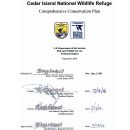What We Do
Wildlife conservation is at the heart of the National Wildlife Refuge System. It drives everything on U.S. Fish and Wildlife Service lands and waters managed within the Refuge System, from the purposes for which a national wildlife refuge national wildlife refuge
A national wildlife refuge is typically a contiguous area of land and water managed by the U.S. Fish and Wildlife Service for the conservation and, where appropriate, restoration of fish, wildlife and plant resources and their habitats for the benefit of present and future generations of Americans.
Learn more about national wildlife refuge is established to the recreational activities offered to the resource management tools used. Using conservation best practices, the Refuge System manages Service lands and waters to help ensure the survival of native wildlife species.
Management and Conservation
Prescribed fire is the primary management tool used to improve wildlife habitat on the refuge. Routine, low-intensity fire promotes new growth and increases plant diversity. It improves nesting and foraging conditions for many species within marsh and forested habitats. Prescribed fire also reduces hazardous fuel accumulations to help prevent more destructive wildfires.
Our Projects and Research
Motus Wildlife Tracking System
The Motus wildlife tracking system is a collaborative research network using coordinated, automated radio telemetry arrays to study movements of small animals. Receivers in Motus towers automatically record the radio signals from radio-tagged wildlife present nearby. Thousands of researchers use the network of 1,250+ Motus towers to study species from bats to albatrosses. Cedar Island NWR hosts a Motus tower, which will record signals from any and all Motus-tagged wildlife nearby, contributing to hundreds of ongoing research projects. More information can be found at https://motus.org/.
